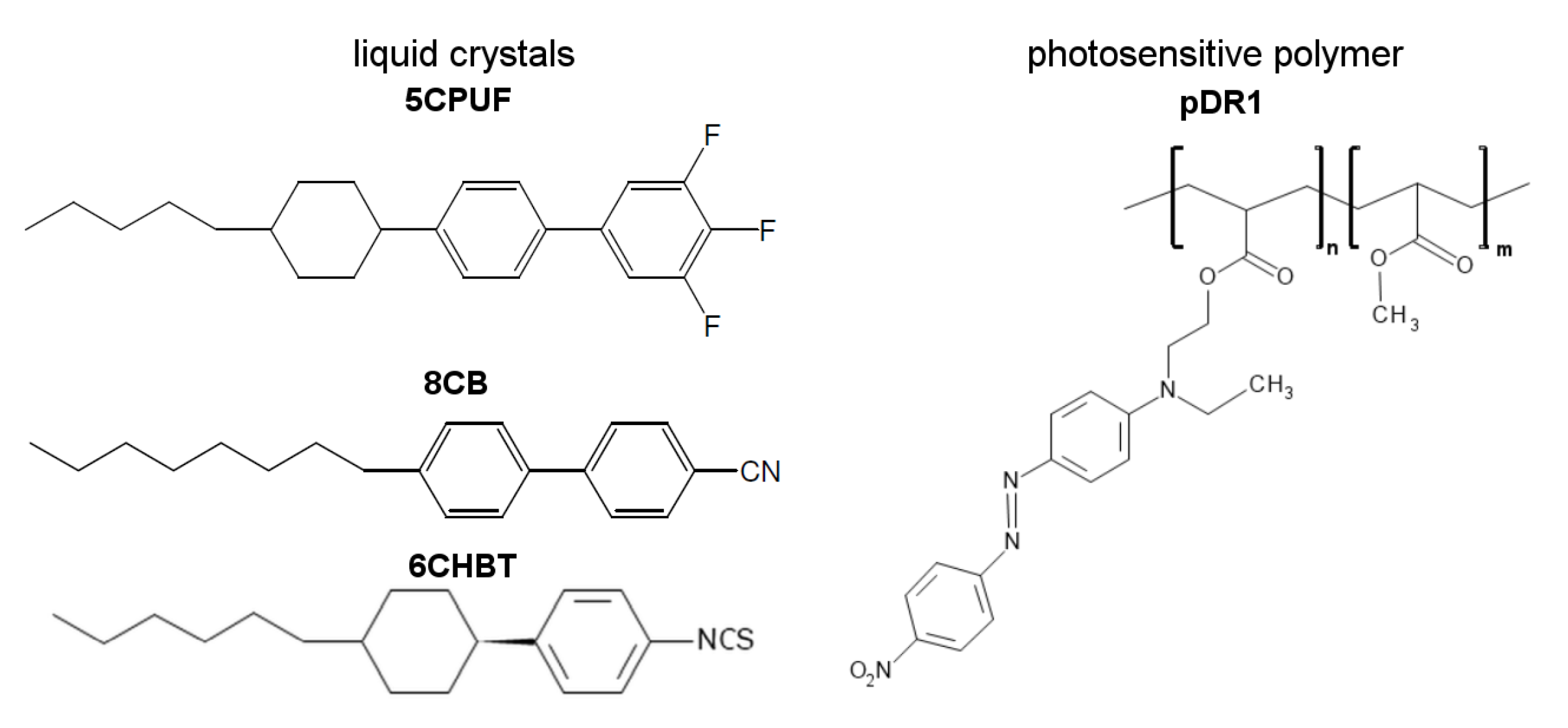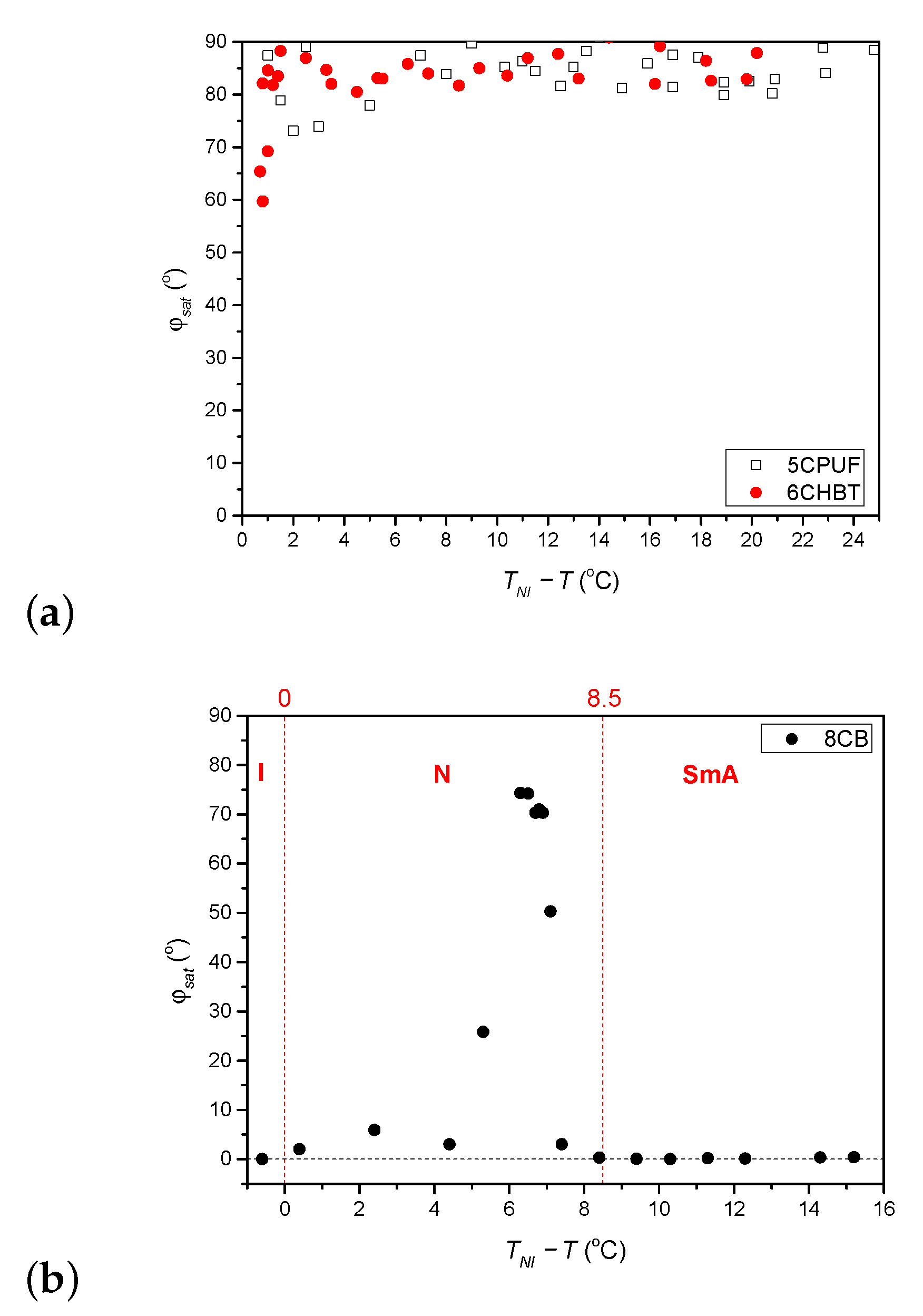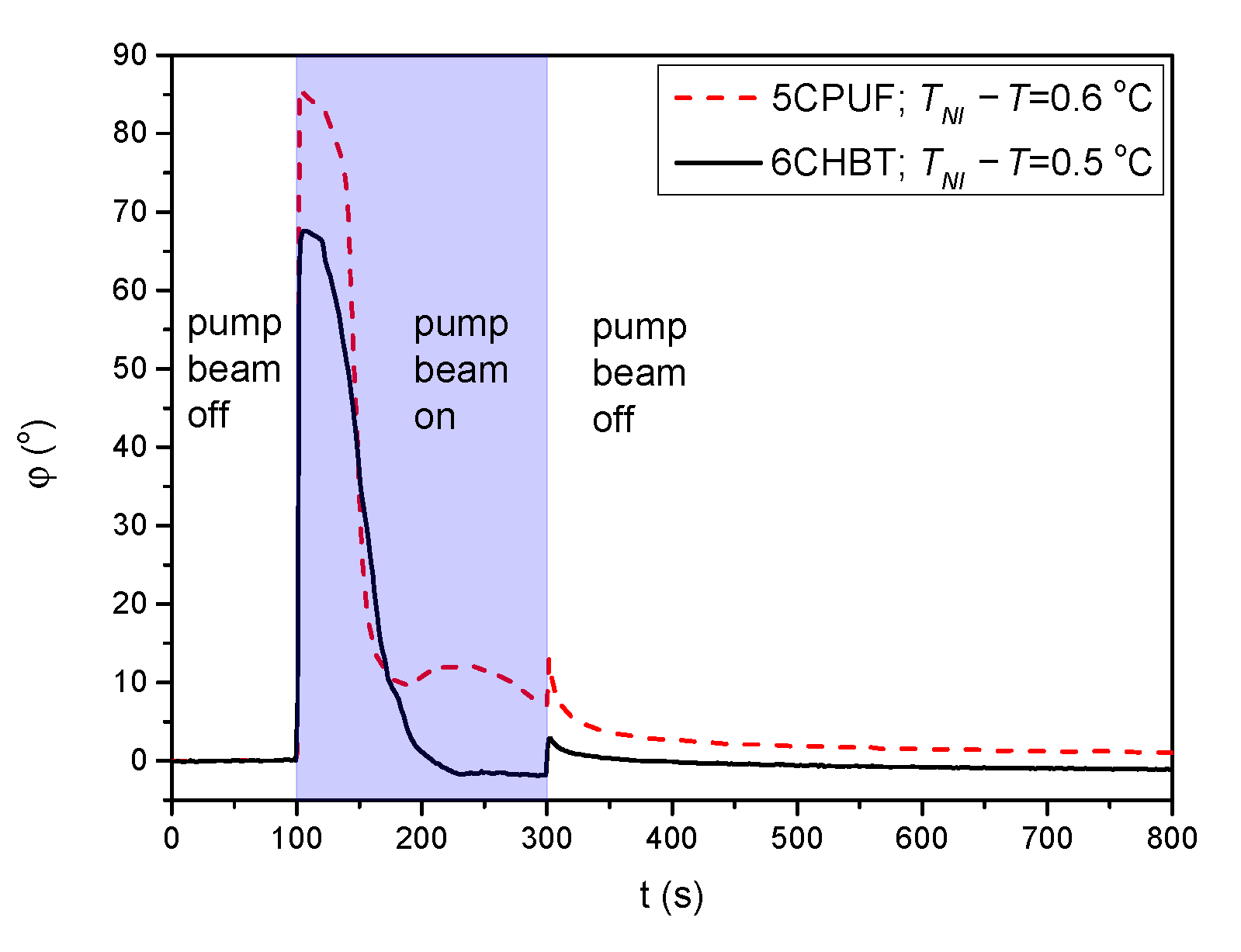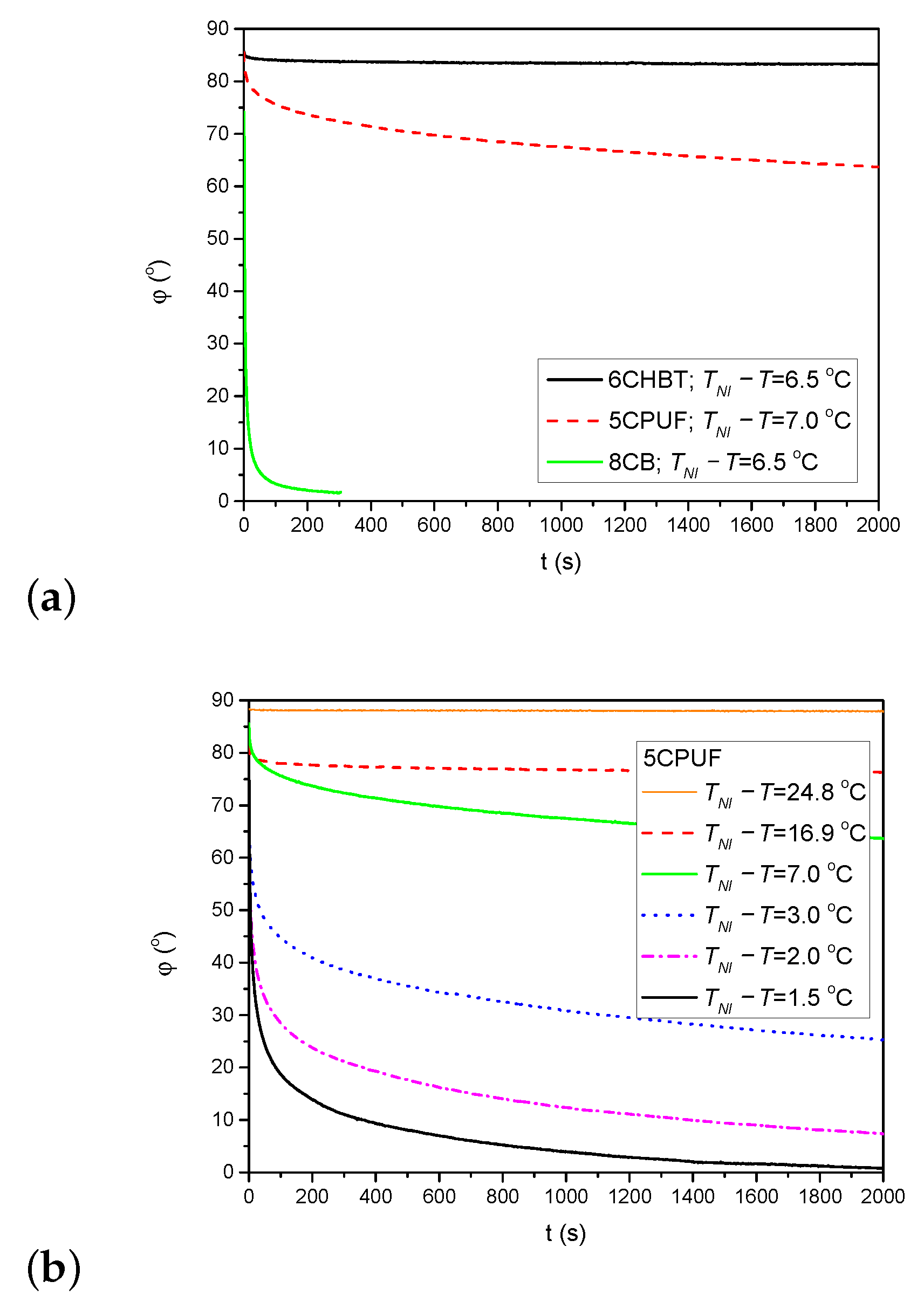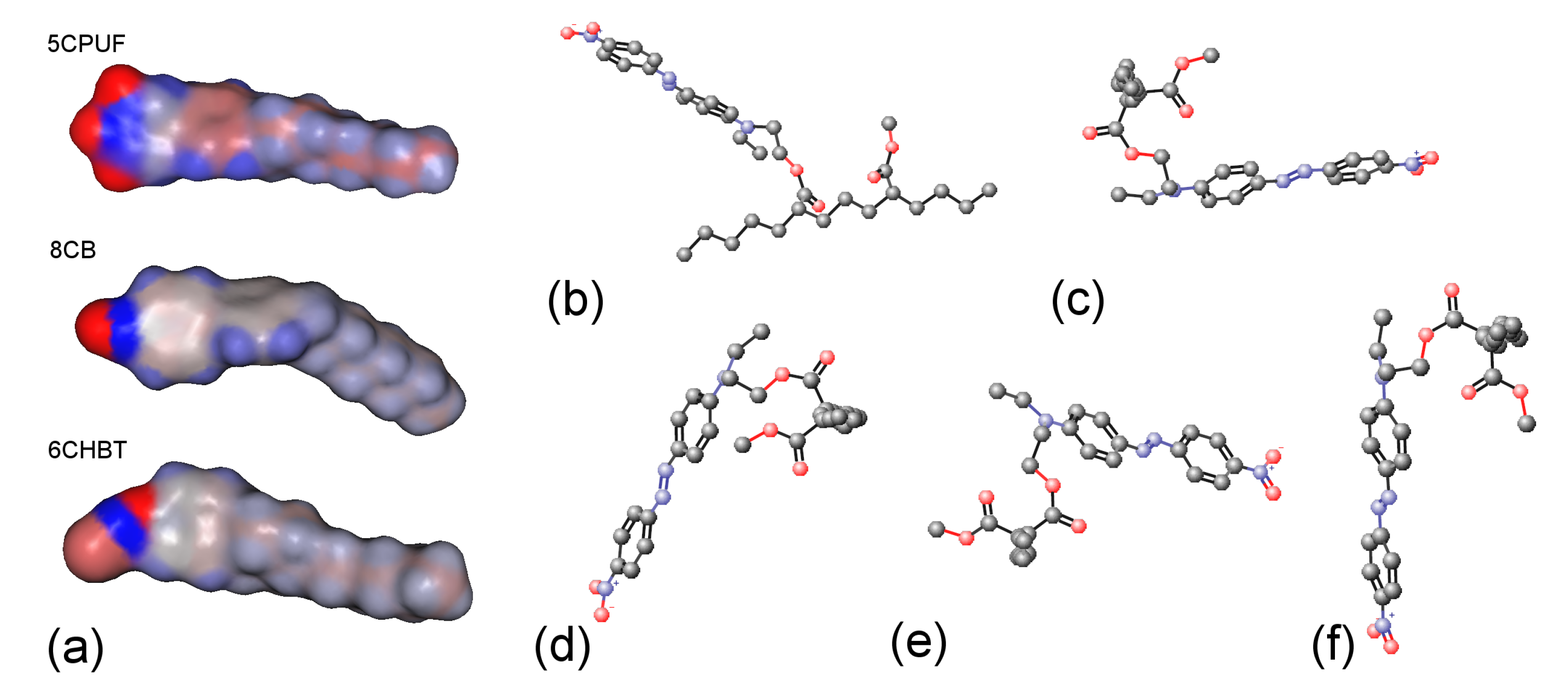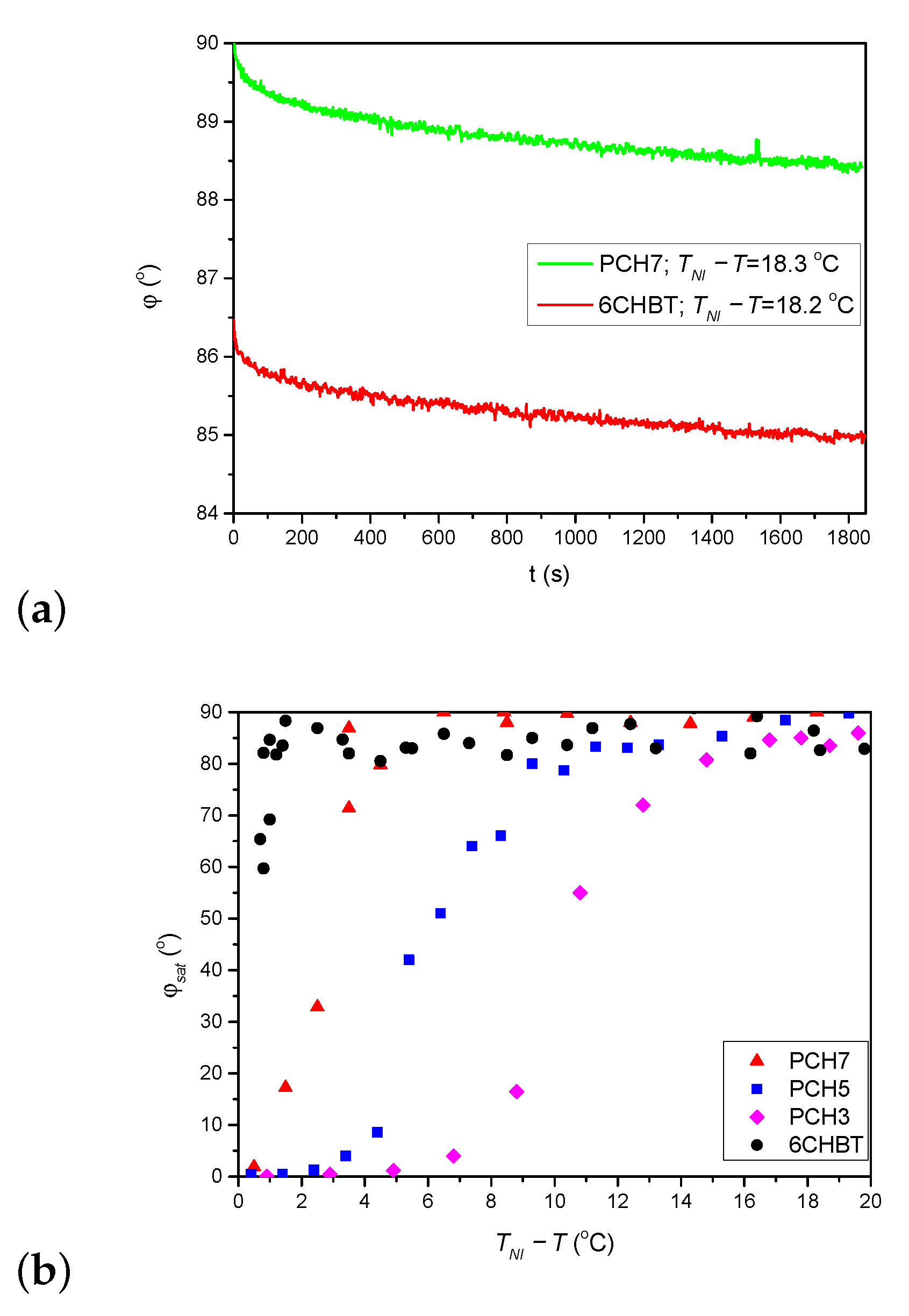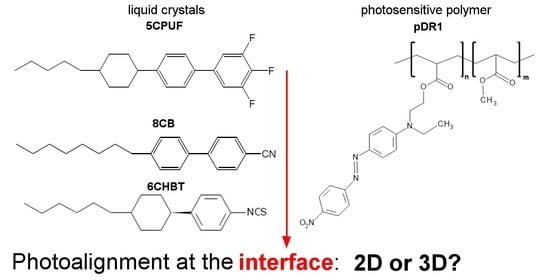1. Introduction
The proper alignment of the molecules at the boundaries is the key factor for correct operation of devices based on liquid crystals (LCs). Standard, well established methods have been developed in the last decades to ensure the required orientation of liquid crystals [
1] and have achieved high technological impact as being the basis of flat LC displays, the research and development of which have now moved mainly to industrial laboratories [
2]. The interaction of liquid crystals with the bounding substrates, however, remained a particularly significant academic research area. Namely, there is a continuous search for alternative methods for aligning LCs that are applicable in diverse novel fields of LC research, such as micro-, nano-, and biotechnology, medicine, polymer and colloid science, photonics, etc. [
3,
4]. One of the most stimulating alternative method is the so-called photoalignment of nematic liquid crystals (NLCs), discovered almost three decades ago [
5,
6,
7]. Photoalignment can be used not only to ensure the desired orientation in LC devices, but opens up the possibility to reorient (control) the liquid crystal director
n through light irradiation in a contactless manner [
8].
The photocontrol mechanisms, as well as the most common photosensitive materials are well described in a review on photoalignment of NLCs [
9]. One of the most popular realization of the photoalignment is to exploit the trans-cis (E/Z) isomerization of azobenzene derivatives [
10]. Two basic mechanisms of photoalignment are known in LC sandwich cells constructed with one photosensitive substrate (with either polymer-, or monolayer of an azobenzene derivative) and one traditionally prepared reference plate. In the first scenario the light irradiation creates cis (Z) isomers that trigger a homeotropic-to-planar transition—this is the so called ‘out-of-plane alignment’, or zenithal photocontrol [
11,
12,
13]. In the other mechanism (‘in-plane alignment’, or azimuthal photocontrol), the liquid crystal molecules remain in the plane of the substrate and the azimuthal angle of the director is controlled with polarized light: after the irradiation the director becomes perpendicular to the light polarization direction [
5,
6,
14,
15].
Recent experiments on azimuthal photocontrol have shown, however, that the above classification of the photoalignment mechanisms is less unambiguous. Namely, beside the azimuthal photoalignment, in a certain temperature range, zenithal photoalignment has also been observed. Moreover, close to the nematic-to-isotropic phase transition of the LC interfacing the photosensitive layer, a temperature induced anchoring transition (from planar towards homeotropic) has also been detected. The results have been explained by the different temperature dependence of the azimuthal and zenithal anchoring strengths at the polymer-LC interface [
16]. Furthermore, it has also been shown that the mechanism of the photoalignment depends on the liquid crystalline molecular structure: the photocontrol of LCs with biphenyl rigid cores substantially differs from that of LCs not having biphenyl group in the molecular structure. The differences have been phenomenologically explained by the presence/absence of the offset stacked
aromatic interactions between the rigid core of the LCs and the azobenzene moiety of the interfacing polymer [
17].
In the current work we provide further evidences of our previous assumptions about the mechanism of photoalignment by using various new types of LCs in the experiments. In particular, we investigate a compound where one of the phenyl group has been modified with three fluorene atoms at 3,4,5 positions, which almost “invert” the molecular electrostatic surface potential (MESP) of the ring [
18]. Additional test measurements have been also performed on a LC compound having similar molecular structure to the PCH homologous series investigated in our previous publication [
17]. The third LC which we investigate is a cyanobiphenyl compound, exhibiting a nematic-to-smectic A phase transition at a temperature
. This allows us to study the effect of pretransitional fluctuations on the photoalignment. Namely, both the bend and the twist elastic constants (
and
, respectively) exhibit an increase (a divergence) near
due to pretransitional smectic fluctuations [
19,
20,
21] which are expected to influence the photoalignment. Finally, we provide MESP for all investigated LC compounds, as well as some of the conformers of the photosensitive polymer, with the aid of which we discuss the possible photoalignment processes.
2. Materials and Methods
NLCs 3,4,5-trifluoro-4′-(4-pentyl-cyclohexyl)biphenyl (5CPUF) and 4-octyl-4′-cyanobi phenyl (8CB) have been purchased from Synthon Chemicals, while 1-(trans-4-hexylcyclohe xyl)-4-isothiocyanatobenzene (6CHBT) from Sigma-Aldrich and were used as received (
Figure 1). The nematic-to-isotropic phase transition temperature
(clearing point) of 56.5
C, 41.5
C and 43.0
C has been found for 5CPUF, 8CB and 6CHBT, respectively. Additionally, a smectic A-to-nematic phase transition has been detected at the temperature
= 33.0
C for 8CB. The photosensitive polymer was polymethyl-methacrylate (PMMA) functionalized with the azo-dye Disperse Red 1 (pDR1—see
Figure 1), obtained from Alphamicron Inc., Kent, OH, USA. The glass transition temperature of the pDR1 has been found around
C, i.e., far above the clearing temperature
of the liquid crystals.
Sandwich cells of typical thickness
m have been prepared: the NLCs have been enclosed between a reference and a photosensitive plate. The reference plates were rubbed polyimide slides from E.H.C. Co. (Japan), ensuring a fixed, planar orientation of NLC (the director
n parallel with the surface of the plate) at the surface. The photosensitive plates have been prepared by spin-coating pDR1 on the glass substrate as described in details in Ref. [
16]. The pDR1 polymer has been dissolved in toluene in concentration of 2 wt.%. Spin-coating has been performed at 800 rpm for 5 s, and then at 3000 rpm for 30 s (all with spin acceleration of
rpm/s). The spin-coated substrates have been annealed preferably overnight in an oven (or alternatively, at least for 2 h) at 140
C. The thickness of the pDR1 layer has been estimated to be in the order of ∼0.1
m, based on the spin-coating experiments on PMMA [
22]. The two plates have been assembled with spacers, and the thickness of the assembled cells have been measured by interferometric method. Liquid crystal materials have been filled in the cells in the nematic phase, few
C below the clearing temperatures,
. Prior and during filling the cell with the NLC, the cell was illuminated with light polarized perpendicular to the rubbing direction on the reference plate, resulting in a good quality planar initial orientation of the NLC at both bounding substrates.
The experimental setup (
Figure 2) for photoalignment measurements is similar to that presented in Ref. [
23]. It is a pump-probe optical setup combined with a lock-in amplifier. The pump beam of a DPSS laser (≈20 mW, 457 nm) entered the NLC cell from the photosensitive side. The polarization direction of the pump beam has been regulated by a rotatable
plate, and the diameter of the beam has been expanded by a lens to a few mm (much larger than the diameter of the probe beam). The probe beam (He-Ne laser, 5 mW, 633 nm) entered the NLC cell at the reference plate and behind the sample it was sent through a rotating polarizer. The intensity of the probe-, and of the reference beam has been detected with photodiodes and the signals were connected to a lock-in amplifier (see
Figure 2). The lock-in amplifier provides the phase and the amplitude of the probe beam.
In order to study the
in-plane component of photoalignment, the polarization direction of the pump beam has been set parallel with the initial director orientation
n. For the determination of the azimuthal photoalignment angle,
, the polarization direction of the probe beam (and that of the reference beam) has been set parallel with the rubbing direction on the reference plate. The polarization direction of the transmitted probe, which is parallel to the director on the photosensitive plate, has been deducted from the phase of the lock-in signal (see
Figure 2).
corresponds to a complete azimuthal reorientation, i.e., the orientation on the photosensitive plate is perpendicular to that on the reference plate. The pump beam has been switched on at a certain moment (when the phase without the pump beam is determined), and is switched off after the saturation of the signal (reaching the value of
, typically after 3 min) enabling to follow the back-relaxation.
To detect the
zenithal photoalignment, the polarization direction of pump beam has been set perpendicular to
n (i.e., no azimuthal photoalignment is expected), while the probe beam was polarized at
from
n, and the amplitude of the signal was measured. With this arrangement, if a significant out-of-plane photoalignment occurs, oscillations in the transmitted light intensity of the probe beam should appear, similarly to the measurements on the electric-, or magnetic-field induced Fréedericksz transition—see e.g., Ref. [
24]. We note, that for a quantitative estimate of the zenithal photoalignment angle,
, besides the sample thickness
d, the temperature dependence of all relevant material parameters have to be known for the NLC.
For the calculation of the molecular electrostatic surface potential (MESP) of the NLC molecules and the conformational changes in polymer pDR1 the MarvinSketch program has been used.
4. Discussion
The choice of the NLC compounds has been motivated by the main goals of the present work, namely:
to confirm the role of the presence/absence of the offset stacked aromatic
interactions between the NLC and the photosensitive polymer, postulated recently [
17];
to get further insights in the role of the molecular structure of the NLC in photoalignment processes;
to find out how the pretransitional fluctuations near the nematic-to-smectic A phase transition temperature influence the photoalignment.
To achieve these goals, both the azimuthal and zenithal photoalignment process, as well as the back-relaxation have been monitored. Additionally, the MESP of the NLCs have been constructed, and possible conformational changes in the photosensitive polymer have been considered.
As stated above, the thiocyanate (SCN) group in 6CHBT does not change significantly the MESP of the adjacent phenyl ring compared to the cyano-group (CN) in 8CB (see
Figure 7a). On the other hand, 6CHBT has similar molecular structure with phenylcyclohexane rigid core as PCH homologue series investigated recently [
17], except the phenyl ring is connected to the SCN polar group instead of CN group in PCH LCs. Therefore, the photoalignment at the pDR1–6CHBT interface is expected to have the same characteristics as those at the interface pDR1–PCH homologue series, namely, efficient azimuthal photoalignment over a wide temperature range of the nematic phase and no considerable zenithal photoalignment [
17]. This expectation is now confirmed by the experimental results: a complete (or close to complete) azimuthal photoalignment has been found almost in the whole temperature range of the nematic phase (except very close to
—see
Figure 3a), and no considerable zenithal photoalignment is detected (
Figure 5b), similarly to the results obtained for the PCH homologous series [
17]. Moreover, the back-relaxation dynamics of 6CHBT resembles to those obtained for the PCH NLCs. This fact is illustrated in
Figure 8a, where the relaxation in 6CHBT is compared with that in PCH7 at about the same relative temperature
C.
In Ref. [
17] the question of possible role of the length of the alkyl chain in photoalignment has been also raised. It was found that the temperature difference
, at which the saturation angle
sharply drops, decreases as the length of the alkyl chain increases (see in
Figure 8b). Considering that 6CHBT in other aspects of photoalignment shares the characteristics with the PCH homologous series, it is straightforward to make a comparison in this respect too. The comparison is shown in
Figure 8b. Clearly, the azimuthal photoalignment is maintained in 6CHBT the closest to
, despite it has a shorter alkyl chain than PCH7 (and has the lowest
among these NLCs on the absolute scale). Therefore, besides the role of the length of the alkyl chain (if any), some other factor(s) influences the process too, which will be considered in the future.
In the case of 5CPUF, the three fluorine atoms attached to the phenyl ring in the structure change the MESP of the adjacent ring (and even that of the next phenyl ring) to a large extent compared to that of the cyanobiphenyl 8CB (see
Figure 7a). These modifications in the MESP of the biphenyl part of the 5CPUF molecules prevent the offset stacked
aromatic interactions between the biphenyl part of the 5CPUF and the azobenzene moiety of the interfacing polymer as it has been outlined recently—see Figure 9 of [
17], and the corresponding explanation there. Therefore, the same characteristics of the photoalignment are expected for 5CPUF as those found in NLCs with phenylcyclohexane, or bicyclohexane rigid core (6CHBT described here, PCH homologous series and ZLI1695 described in [
17]), namely, (i.) a complete (or nearly complete) azimuthal photoalignment in the whole temperature range of the nematic phase (except very close to
, where thermal effect of the pump beam, or the eventual temperature induced anchoring transition [
16] may have influence); (ii.) no considerable zenithal photoalignment; (iii.) in the absence of the offset stacked
aromatic interactions between 5CPUF and the polymer, a much slower back-relaxation than in the cyanobiphenyl NLCs. The experimental results on 5CPUF presented here underpin all these expectations: a (nearly) complete azimuthal photoalignment has been found in the whole temperature range of the nematic phase (see
Figure 3a), no considerable zenithal photoalignment detected (see
Figure 5a), and the back-relaxation is much slower in 5CPUF than in 8CB (see
Figure 6a), or in other cyanobiphenyl NLCs, like 5CB, E7, and E63 (see in [
16]).
Photoalignment of cyanobiphenyl NLC compounds (5CB, mixtures E7 and E63) interfacing the pDR1 polymer has been extensively studied recently [
16,
17]). In these systems an incomplete azimuthal photoalignment has been measured over a wide temperature range of the nematic phase, while a considerable zenithal photoalignment has been found in the temperature range in which the azimuthal photoalignment is inefficient. Furthermore, just below
, a temperature induced anchoring transition has been detected from planar towards homeotropic orientation of cyanobiphenyl NLCs E7 and 5CB. Moreover, the back-relaxation of the cyanobiphenyl compounds from the photo-reoriented state has been found much faster than in NLCs with phenylcyclohexane, or bicyclohexane rigid core. These experimental results have been explained by the different temperature dependencies of the azimuthal and zenithal anchoring strengths at the NLC–polymer interface [
16], and by the offset stacked
interactions between the biphenyl core of the NLCs and the azobenzene moiety of the polymer that induce additional stresses acting against the photoinduced
trans-cis isomerization in the system [
17].
In the nematic phase, the 8CB cyanobiphenyl compound is expected to possess similar photoalignment characteristics as the above mentioned cyanobiphenyl NLC compounds, except slightly above the nematic-to-smectic A phase transition temperature,
, where pretransitional smectic fluctuations are present. The experiments reported here confirm most of these expectations, namely, in the high temperature range of the nematic phase (
C) no considerable azimuthal photoalignment has been detected (see
Figure 3b), while the oscillation in the amplitude of the transmitted light intensity indicates considerable zenithal photoalignment (see
Figure 5c at
C). With the decrease of the temperature, in the narrow range of 5.3
C
C an incomplete azimuthal photoalignment (
Figure 3b), and no considerable zenithal photoalignment (see
Figure 5c at
C) has been found. With further decrease of the temperature, in the nematic phase (7.1
C
C), as well as in the smectic A phase (
C), both the azimuthal and the zenithal photoalignment vanish. In the nematic phase it is presumably due to the pretransitional fluctuations, which significantly increase the bend and twist elastic constants [
19,
20,
21], that are the most important parameters for the azimuthal and zenithal photoalignment, respectively. In the smectic A phase no azimuthal, nor zenithal photoalignment is expected, since there, the bend and twist deformations involve changes in the layer spacing and so are likely to be of very high energy [
25].
One should note here, that 5CB and 8CB are compounds of the same homologous series (8CB having a longer alkyl chain), and that the temperature range of the nematic phase (from the room temperature) is roughly the same. In 5CB no considerable azimuthal photoalignment has been observed down to
C (room temperature—see
Figure 2 of [
16]). In contrast, in 8CB a relatively large (though incomplete) azimuthal reorientation has been found already at
C—see
Figure 3b. Consequently, the question of possible role of the length of the alkyl chain in photoalignment mentioned above (and discussed for PCH series in [
17]) rises again. However, the absolute value of
is higher for 8CB than for 5CB, similarly to the case for PCH compounds, where
increases with the increase of the length of the alkyl chain. Therefore, the clarification of this question remains for future studies.
Finally, we discuss conformations of the photosensitive polymer, pDR1. We are aware that considerations made in
Section 3.4, and partially shown in
Figure 7b–f are oversimplified: they consider only a particular (one of the most simple) possible segment of the polymer chain, do not take into account the whole polymer chain, the entanglements and the interactions between the chains, the actual phase of the polymer, etc. However, to our belief, even such an oversimplified picture can give some hints that may bring us closer to understanding the photoalignment process at the pDR1–NLC interface. Namely, for the explanation of experimental results obtained in [
16] (including the temperature induced anchoring transition), a different temperature dependence of the zenithal and azimuthal anchoring strengths at the pDR1–NLC interface has been proposed. The different temperature dependencies of the anchoring strengths have been associated with the flexibility of the spacer consisting of two methylene units connecting the PMMA main chain with the azobenzene moiety (see pDR1 in
Figure 1) [
17].
Analysing the conformers of the pDR1 segment, and observing the
Figure 7c–f, however, it seems more likely, that for the different temperature dependence of the zenithal and azimuthal anchoring strengths the flexibility of the PMMA polymer main chain is responsible (rather than that of the two methylene units spacer). As one can see in
Figure 7c–f, the trans-isomer of the azobenzene moiety can take almost any direction (from horizontal to vertical) at an energy expense of few
. The above assumption is supported by our latest, preliminary experiments at the interface of the derivatized methyl red (dMR) monolayer and cyanobiphenyl NLCs, 5CB as well as mixture E7 [
26]. The dMR monolayer has been prepared by chemisorption of its triethoxysilane unit on the activated glass substrate. The triethoxysilane unit is connected to the azobenzene containing methyl red via three methylene units, i.e., the spacer unit here is longer than in pDR1. For the molecular structure of dMR, and for the preparation procedure see, e.g, [
27]. Our preliminary measurements on these systems have shown a quite efficient azimuthal photoalignment of 5CB and E7 over the whole temperature range of the nematic phase, an absence of zenithal photoalignment, and a much slower back-relaxation than in systems with pDR1. All these observations indicate that the eventual flexibility of the methylene spacer does not play a role in the three-dimensional photoalignment, seen at the interface of cyanobiphenyl NLCs with pDR1.
